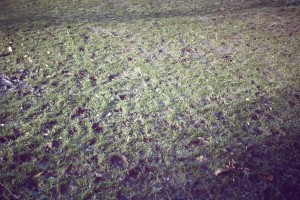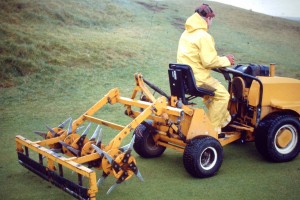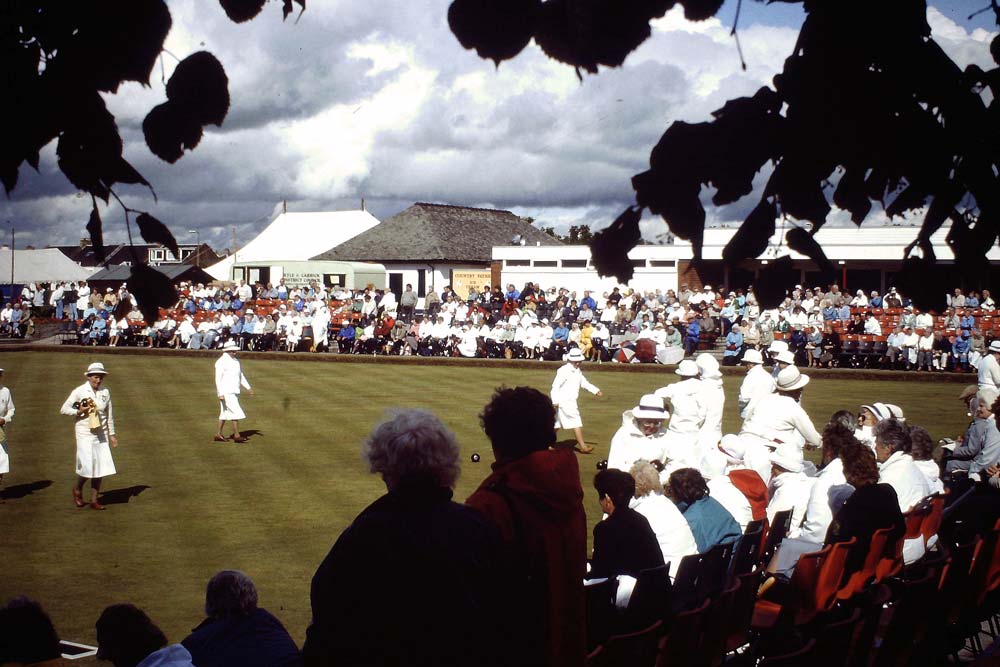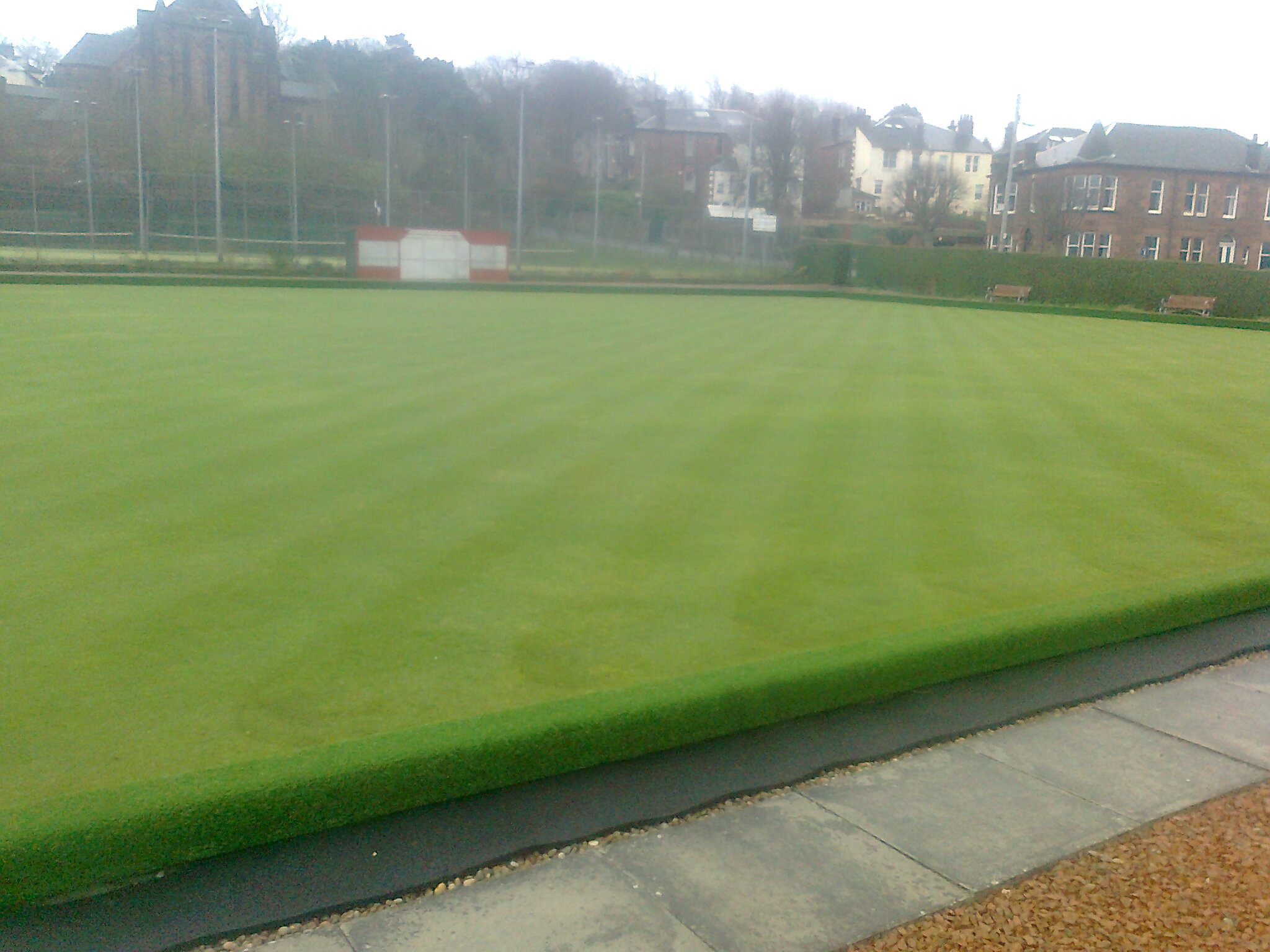How to Manage Wet Weather Problems In Turf Maintenance.
Why does water cause problems.
Wet weather and turf maintenance are not good bedfellows, as anyone involved in the industry, particularly over the past few Summers, can testify.
When more rain is falling than the drainage capacity can cope with, the root zone becomes waterlogged. This means that all of the air is forced out and the grass plants, or most other plants for that matter, simply drown.
How land drains.

Field capacity is the term used to describe the optimum water holding capability of the root zone. Once field capacity is reached, the excess water should then drain away as more rain falls, thereby maintaining the air to water ratio in the soil.
When the drainage system is inadequate or non existent, or the rainfall is excessive, the best result you can hope for is short term flooding.
At worst, you may see severe long term problems with increasing compaction, and decreased wear resistance, resulting eventually in the death of your turfgrass.

If your waterlogged lawn sees a lot of traffic, the soil quickly turns to mud, covering and smothering the grass itself. Then, when the lawn eventually dries up, it leaves a layer of de-structured soil that hardens and is very difficult to return to a healthy condition.
How Aeration Can Help Grass Surfaces Drain.
Whether we are looking after a golf course, a playing field, a domestic lawn, or any other type of grass land, the methods for minimising and then repairing the damage are the same.
First and foremost is ensuring that excess water is drained off as quickly as possible. This entails not only making sure adequate drains are in place, essential to ensure the water draining through has somewhere to go, but also ensuring the root zone is well aerated to allow the water free passage through the soil profile.
Even very sandy root zones need regular aerating as the grass is constantly forming thatch and fibre, which will restrict the drainage capability over time. And the passage of feet and machinery is constantly compressing the surface, which is called compaction.
Aeration can be done manually on smaller areas by simply getting the garde fork out, and evenly forking the entire area. On larger spaces you might need a little mechanical help. Machines fitted with slit tines, solid round, or diamond tines, open up space in the soil perfectly, or you may want to choose hollow coring, where a plug of soil is removed. Examples here.

In my experience the best method for forming a good healthy, free draining soil, is slit tining with 6″ to 8″ (15 to 20 cm approx) tines from September through to early March, augmented by 4″ (10 cm) chisel tines in the Summer months. This forms a very extensive root system essential to good drainage.
There are also modern versions of the Sarrell Roller available now which is covered in small spikes, 1″ to 2″ long (2.5 to 5cm), to stop the surface from sealing.
Care has to be taken when using the verti-drain, a deep solid spiker with heave, or when hollow coring, as if there is not an efficient underlying drainage system in place the holes fill up causing the soil to saturate even more quickly.
Other methods of Dealing with Waterlogging
Another way to help water to drain quickly, is to shape the land to encourage flow and minimise puddling. First you would ensure any hollows are levelled, before introducing slopes to the edges of an area to help with run off.
You would always attempt to minimising traffic where possible during the wet periods, letting the water drain before using the grass area. It is also essential to move standing water by pushing it off as quickly as possible. This avoids these submerged areas going sour and dying completely.
Good every-day maintenance practices will also help to avoid waterlogging. These include regular top-dressing using a good clean sand which has at least 75% of it’s particles in the 0.5 to 0.75 mm range. This should preferably be done just before slitting, thus introducing some of the sand into the root zone. An even courser washed sand can be used to improve drainage on lawns, as long as they are not being cut lower than 20 mil, as anything less would damage the mower blades.
Fertiliser applications should be kept to a minimum to avoid excessive thatch build up, and regular verticutting / scarifying will also help to control the thatch.
Repairing the Damage of Flooding
Of course, sometimes there is so much water that damage can’t be avoided. In this case remedial work is required as soon as possible.
Hollows that are constantly being waterlogged would ideally be restructured, preventing the problem entirely. If this isn’t possible then forking, followed by an application of charcoal and/or calcified seaweed will help to alleviate the sourness and stimulate new growth. Find these here.
Larger areas that have been badly damaged, as in the picture above, require complete renovation, including cultivation, to restore the soil structure. Again, the addition of charcoal and calcified seaweed is very beneficial, along with mixing in a good sand, before either reseeding or turfing. Improving the under lying drainage system should also be considered, if possible.
Flooding and the inevitable waterlogging problems is certainly a problem that’s not going away, especially given the apparent change in weather patterns in the UK. As a result, much more consideration will have to be given to minimising the effects when planning new projects in future, as well as improving all aspects of turf maintenance to keep the surfaces as dry as possible.



Duncan, I am conducting research into soil compaction management for sports turf. My topic is, ideal compaction for soil health & monitoring for sports turf. question 1 , have you experienced over decompaction of sports turf & the problems it caused.
question 2. Have you experienced a soil health monitoring for sports turf.
I hope to write a process that will enable local sites to be accessed giving an Ideal Compaction Rate, mm X force. once a turf manager sets his ICR number, work practices can be organised to manage the soil health within ICR Zone. 10% up & down of the ICR. ( the balance of water,oxygen & solid matter)
Thankyou, Regards.
Tennyson Blake
Australia
Hi Tennyson, good to hear from you.
As a fine turf manager I have always found compaction to be our biggest enemy. That`s why we now have such a wide variety of aeration equipment available.
When I started over forty years ago there was a very limited range, so often we had to resort to using a garden fork in the worst scenarios.
At its worst, severe compaction restricts water movement, and vastly reduces air space in the root zone. I have seen many instances of turf just rolling up when a spiker is first introduced as there are no roots whatsoever.
The STRI have developed a machine that measures the hardness of the turf, which gives an indication of thatch levels and soil compaction, but I have never personally used this.
Most turf managers will monitor the compaction levels by visual inspection of the root zone when changing holes or by taking sample hollow cores. It is also easy to tell the health of the root zone by the quality of sward, the rate of drainage, and by how quickly the turf responds to drought.
For technical information on how compaction is measured I would suggest getting in touch with the STRI at Bingley.
I hope the research goes well. If you wish me to go into a bit more detail about the problems experienced with compaction, I will be happy to do so.
Duncan.